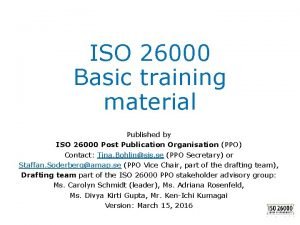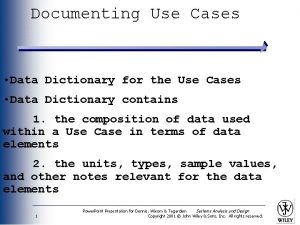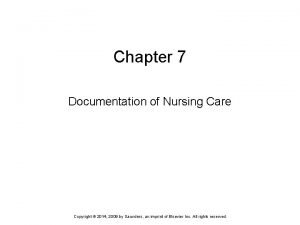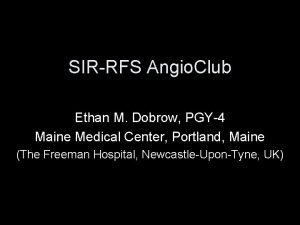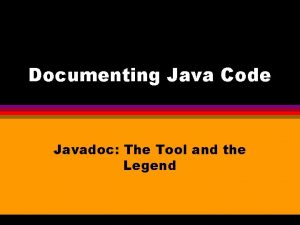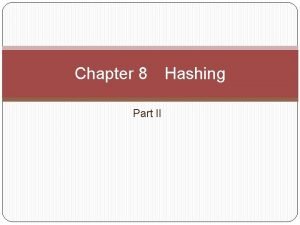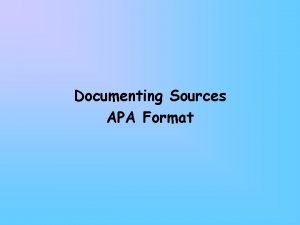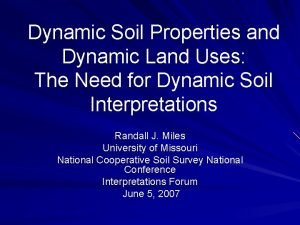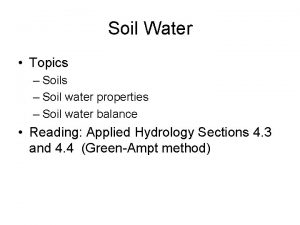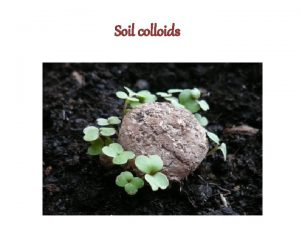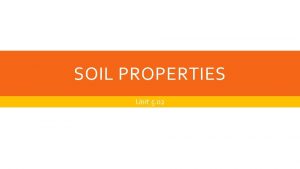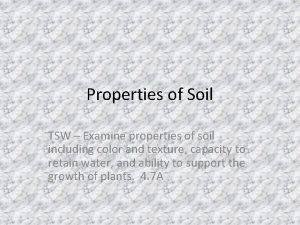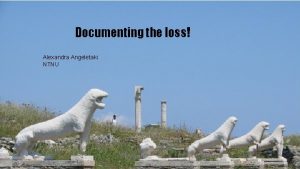Documenting Soil Change using Dynamic Soil Properties and





















- Slides: 21

Documenting Soil Change using Dynamic Soil Properties and Ecological Site Descriptions Skye Wills NCSS, 2011

Soil and Ecosystem Change • Soil Change Guide – Document change in soil function applicable over the entire extent of a soil series or component phase – When possible, Ecological Sites and associated State and Transition Models inform study design and interpretation – Dynamic soil properties collected concurrently with vegetation properties

Space and Time • Some conceptual model is needed to separate the soil component being evaluated into conditions that can be compared in space – Space for time substitution allows us to interpret change over time or caused by management system – Statistical inference: where can results be applied

Conceptual Model • Ecological Site with State and Transition Model

Begay DSP Project (Utah) • Used STM to separate ecological site (R 035 XY 215 UT) and the correlated soil map component phases into conditions for comparison – Reference State -Community Phase • 1. 1 Perennial grassland/shrubland – Alternative State -Community Phase • 4. 1 and 4. 2 Cheatgrass Dominated/Monoculture


Organic carbon % High and low values of reference state B to 25 cm 2 cm to base of A 0 -2 cm Bulk density PG-S = perennial grass-shrub; AG = Annual grass (cheat grass) n=4


Conceptual Model • Ecological Site with State and Transition Model • Add additional land uses – assume these represent different states and that we understand the dynamics at work between these land uses.

MLRA 77 C (TX) Amarillo DSP Project • Chose conditions for study based on past and current land use – Rangeland – ‘Degraded’ shortgass, shrub invaded (R 077 CY 034 TX; Shrub Dominant Community 3. 1) – Conservation Reserve Program – previously cropped, currently dominated by ungrazed introduced grasses – Cropland –Irrigated conventionally tilled cotton

CRP – variable conditions and past management difficult to fit within STM concepts Cropland – could conceivably be considered a separate state. However, the large energy inputs available could overwhelm any subtle ecological dynamics in the site.

Amarillo: Wet Aggregate Stability Standard Error Proportion > 0. 25 mm % Mean Weight Diameter mm Standard Error Mean Weight Diameter mm Mean Proportion > 0. 25 mm % Shrub (3. 1) 4. 81 a* 0. 25 0. 84 a 0. 04 CRP 2. 73 b 0. 22 0. 55 b 0. 03 Crop 0. 43 c 0. 22 0. 14 c 0. 03 * Means with same letter are not significantly different (P=0. 05) Ted Zobeck, personal communication 4/20/11

Conceptual Model • Ecological Site with State and Transition Model • Add additional land uses – assume these represent different states and that we understand the dynamics at work between these land uses. • Chose to evaluate management systems within one land use – Pasture – Forest – Crop

Idaho Threebear project • Chose to evaluate management conditions in forest land – Mature forest – Clear-cut and planted forest

Threebear Results

MLRA 106 (NE and KS): Kennebec Soil • Chose to evaluate management systems within cropland – Generally, corn/soybean rotation with • Conventional tillage system • No-till system • “organic” system – While this sounds like a straightforward comparison there are many variations of each of these management systems. Deciding what to compare and what to include in each was a major difficulty.

Total C stocks (Mg ha-1 to 40 cm) % WAS Kennebec Results

Using ESDs to Interpret Soil Change • An ESD and particularly the state and transition model provide context for making management recommendations and interpretations • It also segments a soil map unit component phase into conditions relevant for management – That is – this component with the same community phase present will likely have the same properties and respond to management in the same way

Using ESDs to Interpret Soil Change • Begay Project – the STM supplies contextual information about the ecological dynamics of the site • Amarillo Project – While the STM provides information about range and CRP land – it doesn’t tell us how broadly we can apply the results from the cropland or what processes are important for maintaining or restoring ecosystem function

Ongoing Projects • MLRA 133 A (GA)Tifton – Longleaf Pine/Wiregrass vs. Pasture – Data collection being done concurrently with ecological site data collection – Presents challenges …………but should allow us to interpret and infer ecosystem change • MLRA 80 A (OK and KS) Kirkland – Claypan Prairie Rangeland vs. Cropland – Conventional and no-till management systems within cropland use will be sampled

Acknowledgements • • • Arlene Tugel Cindy Stiles Ted Zobeck Laurie Kiniry Craig Bird Gerald Crenwelgie • • Dave Kohake Bruce Evans Judy Ward Brian Gardner
 Iso 26000 7 core subjects
Iso 26000 7 core subjects Documenting use cases
Documenting use cases Source oriented charting nursing
Source oriented charting nursing Week by week plans for documenting children's development
Week by week plans for documenting children's development Sir rfs
Sir rfs Documenting java code
Documenting java code Living soil vs dead soil
Living soil vs dead soil Living soil vs dead soil
Living soil vs dead soil Transferered
Transferered Extensive vs intensive
Extensive vs intensive Physical and chemical properties
Physical and chemical properties Expansive soil properties
Expansive soil properties Chapter 1 science and the environment
Chapter 1 science and the environment Evidence of chemical change
Evidence of chemical change Absolute change and relative change formula
Absolute change and relative change formula Whats the difference between physical and chemical changes
Whats the difference between physical and chemical changes Supply and demand curve shifts
Supply and demand curve shifts What is an example of chemical and physical change
What is an example of chemical and physical change Rocks change due to temperature and pressure change
Rocks change due to temperature and pressure change Whats the difference between physical and chemical changes
Whats the difference between physical and chemical changes First and second order change
First and second order change Dynamic hashing using directories
Dynamic hashing using directories
